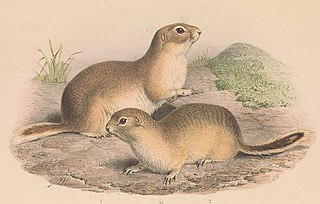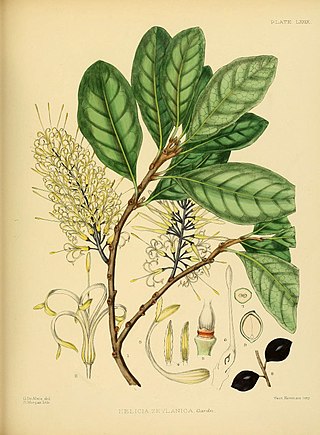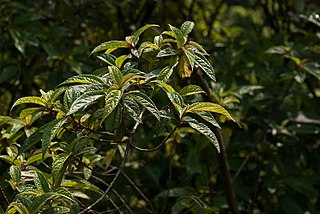
Lavandula is a genus of 47 known species of perennial flowering plants in the mints family, Lamiaceae. It is native to the Old World, primarily found across the drier, warmer regions of mainland Eurasia, with an affinity for maritime breezes.

Convolvulaceae, commonly called the bindweeds or morning glories, is a family of about 60 genera and more than 1,650 species. These species are primarily herbaceous vines, but also include trees, shrubs and herbs. The tubers of several species are edible, the best known of which is the sweet potato.

Garcinia is a genus of flowering plants in the family Clusiaceae native to Asia, America, Australia, tropical and southern Africa, and Polynesia. The number of species is disputed; Plants of the World Online (POWO) recognise up to 400. Commonly, the plants in this genus are called saptrees, mangosteens, or garcinias, and is one of several plants known as by the name "monkey fruit".
Inga pedunculata is a species of plant in the family Fabaceae. It is found only in Brazil.
Hypericum asplundii is a species of flowering plant in the family Hypericaceae. It is endemic to Ecuador, where it is known from a single collection made outside of Machachi.
Hypericum quitense is a species of flowering plant in the family Hypericaceae. It is endemic to Ecuador. Its occurs in several types of habitats at elevations between 2,000 and 4,050 meters in the Andes.

Hypericum scopulorum is a species of flowering plant in the family Hypericaceae. It is endemic to Socotra, an island archipelago that is part of Yemen. It is a common plant in shrubland habitat, and it is a dominant species in some areas along with Cephalocroton and another local endemic, Libinhania rosulata.
The Henderson fruit dove, Henderson Island fruit dove or scarlet-capped fruit dove is a species of bird in the family Columbidae.

The Mongolian ground jay or Henderson's ground jay, is a species of bird in the family Corvidae.

The Alashan ground squirrel is a species of squirrel. It is native to China and Mongolia.
Calceolaria pedunculata is a species of plant in the Calceolariaceae family. It is endemic to Ecuador.

Helicia is a genus of 110 species of trees and shrubs, constituting part of the plant family Proteaceae. They grow naturally in rainforests throughout tropical South and Southeast Asia, including India, Sri Lanka, Indochina, Peninsular Malaysia to New Guinea and as far south as New South Wales.
Convolvulus kossmatii is a species of plant in the family Convolvulaceae. It is endemic to the island of Abd al Kuri in the Socotra archipelago of Yemen. Its natural habitat is subtropical or tropical dry shrubland.

Pratia is a formerly recognized genus of flowering plants in the family Campanulaceae, native to Asia, Australia and New Zealand. Along with other genera, such as Hypsela and Isotoma, it is now included in Lobelia.

Acronychia pedunculata is a large shrub or small tree of the understory, gaps and fringes of low country and lower hill tropical forests of tropical Asia.

Halimione is a plant genus from the subfamily Chenopodioideae of the family Amaranthaceae. It is a sister genus of Atriplex and is included in that genus by Plants of the World Online.

Scalesia pedunculata is a flowering plant species in the family Asteraceae, growing to a slender tree, and found in dense stands on the humid windward coasts of the islands of Santa Cruz, San Cristobal, Santiago and Floreana in the Galapagos Islands. The Galapagos archipelago lies in the southeast trade wind zone, so that climate and weather are dominated by the moisture-bearing trade winds and the topography of the islands. In general, the windward sides of the islands have a much higher precipitation than the leeward sides. Scalesia pedunculata is regarded as vulnerable because of human encroachment, invasive introduced plant species such as Cedrela odorata and Psidium guajava, and grazing by introduced goats. Fires and cutting for fuel are also contributory problems, though the tree's wood is soft, with a large, pithy centre.
Castanopsis pedunculata is a tree in the family Fagaceae. The specific epithet pedunculata means 'having a peduncle'.

Oreocnide pedunculata, the purple woodnettle or longpedicel woodnettle, is a species of flowering plant in the family Urticaceae, native to south-central and southern Japan, the Ryukyu Islands, and Taiwan. A shrub or small tree 2 to 5 m tall, it is found growing in valleys and forest edges at elevations from 100 to 1,200 m. Its leaves are an important food item for Formosan rock macaques and Japanese macaques.
Serruria pedunculata, the fan-leaf spiderhead, is a flowering shrub that belongs to the genus Serruria and forms part of the fynbos. The plant is endemic to the Western Cape and occurs in the Elandsberge among other places.












